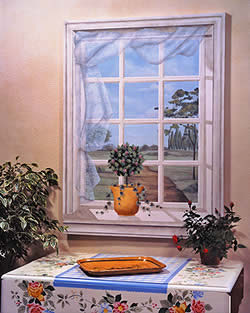
Trompe Loeil
(pronounced tromp-loy)
Typically, trompe l'oeil is used to describe illusions that appear three-dimensional and feature strong highlights and shadows: To successfully fool the viewer into thinking the objects are real.
by Stacey Enesey Klemenc
a French term literally meaning “to fool the eye,” describes a painting that when viewed from the right place deceives onlookers into thinking that the object or objects they’re seeing are real. It can be called the decorative artist’s ultimate gag, a visual joke that only needs to trick the viewer for a moment. The punch line is delivered the instant the onlooker realizes he’s been fooled. Typically, trompe l’oeil is used to describe illusions that appear three-dimensional and feature strong highlights and shadows. To successfully fool the viewer into thinking the objects are real or that a space exists where there is no space, artists usually paint still-life objects or scenes in their real-life size with meticulously placed shadows that make parts of the objects seem to protrude into the viewer’s space.
Trompe l'oeil can be called the decorative artist's ultimate gag, a visual joke that only needs to trick the viewer for a moment. A punch line is delivered the instant the onlooker realizes he's been fooled. |
Out of all of the painting styles, this one requires more than knowledge and experience. To be an accomplished trompe l’oeil painter, few will argue that the main ingredient needed is talent.
“Traditionally trompe l’oeil refers to architectural illusions of elements such as molding, balustrades, capitals, columns and windows-that type of thing-where artists typically use value contrasts in shades of gray to create an illusion of something carved or detailed,” says Melanie Royals, owner of Royal Design Studio in San Diego, California, and author of “Trompe L’Oeil Murals Using Stencils.” “Now it’s a buzz word that people are using [incorrectly] to describe all sorts of murals.”
As a basic prerequisite, Royals suggests that the beginning tromp l’oeil painter take a drawing class at a community college to learn more about perspective, value contrast and texture before attempting a trompe l’oeil painting. “These three things done correctly will lend realism and polish to your painting, whatever your skill level,” she notes. “You definitely need artistic skill, but technical ability and art theory are things that can be studied and learned,” she adds. “Some people have natural ability and others have to study and work at it more.” There are several decorative painting schools across the country that offer classes in trompe l’oeil, some focusing on a certain element such as drapery or molding. Usually, sessions run from three to five days long and involve painting a sizeable mural, say 3-by-5 or 4-by-8 feet, which students take home with them. “Trompe l’oeil mural classes are valuable because they are focused on specific techniques for mural painters and they get you there faster. Instructors use a step-by-step approach and if you make a mistake they are right there to show you how to correct it. But you can’t learn everything you need to know in three days. It’s a continuous developmental process,” says Royals. Whereas it can take years of study and practice to master freehand painting skills, not to mention brush and blending techniques, there is hope on the horizon for aspiring trompe l’oeil artists that want to get in on the action now. And that hope is in the shape of a growing assortment of stencils and patterns.
Royals, a self-taught artist who began specializing in stencil design 18 years ago, came out with her initial line around 1994. “And it’s really taken off,” she says. “The entire decorative painting market, including stencils, is suddenly huge… and growing!” There are thousands of stencils on the market today, everything from dogs, dinosaurs and books to ivy, architectural elements and angels. Many, like Royals’, are multilayered to help artists easily produce an illusion with depth and dimension.
“Each layer contains different design elements and the finished product has more of a hand painted look to it,” she says. Because of the overlays, there are no telltale stencil bridges either. Stencils definitely speed up the process “since the design work has already been done. You just have to follow the pattern and visually separate the different elements by using more value and color contrast. You are still hand painting the elements and using your individual artistic skill, but the stencil definitely offers many advantages,” Royals explains. “Careful study of the relationships between the various elements and correct shading are the most important things,” she says, adding that most painters use acrylics because they dry so quickly. “I tell my students: ‘Turn up the volume on your contrast and your images will really pop.’ And with the proper shading, you can bring that image to life.” If used correctly, stencils can produce elements in the foreground that have crisp colors, detailed shading and well-defined edges. Elements in the distance need to fade in color value and intensity, and be softer, fuzzier-which is not so easy to achieve with a stencil. Also, “Stencils are only cut from one perspective and you can’t make adjustments in size. The problem with stenciling a mural is that you need things in different scales, depending on their relative positions within the mural, and you need to be careful when placing your stenciled elements so that they make sense in the overall composition. Everything has to correlate to the same vanishing point.” |

